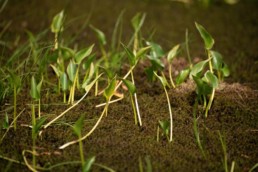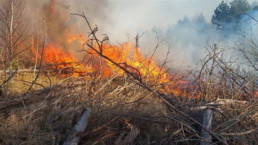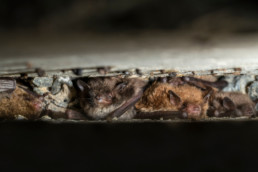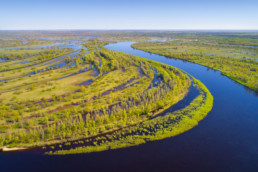Meeting on the ground: disturbed mires of Ukrainian Polesia are waiting for restoration
Experts from the “Polesia – Wilderness Without Borders” project and our partner organization the Michael Succow Foundation visited Ukraine. The visit was dedicated to the prospective restoration of disturbed and degraded mires in the Ukrainian part of Polesia. Its program included meetings with stakeholders, trips to protected natural areas and a round-table session.
The delegation’s members discussed the cooperation prospects with executives and employees of Cheremskyi, Rivnenskyi and Poliskyi nature reserves as well as the Chornobyl Radiation and Ecological Biosphere Reserve. In all these protected areas there are drained mires with good prospects for successful restoration – its feasibility was assessed by experts of the Michael Succow Foundation.
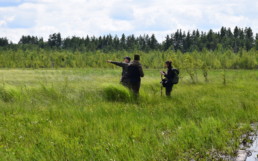
An important task was to listen to opinions of different groups of stakeholders. The position of specialists of the nature reserves is clear: they know the benefits of the mires’ restoration better than others and therefore highly appreciate the international assistance in organizing this work and demonstrate their willingness to cooperate. Their support is extremely valuable, just like the one of the State Agency of Water Resources of Ukraine.
At the same time, the opinions of the local communities are not always unambiguous. On the one hand, a stricter protection regime and rewetting of drained areas may mean certain limitations for economic activities of the local residents. On the other hand, lack of pure water caused by drainage is the argument that makes many people change their minds in favor of the mires’ restoration.
Olga Denyshchyk, scientific project coordinator at the Succow Foundation
"All the stakeholders in Ukraine are constructive, interactive and ready to cooperate more than ever before. This is truly inspiring. Peatland restoration is getting a strategic meaning, not only as freshwater reservoir, but also as a defense line. A lot of communities in Polesia are looking for investors and ready to consider any ecologically-sustainable offer. If you have something in mind, please do reach us out!"

Members of the foreign delegation accompanied by Ukrainian experts visited Cheremskyi, Rivnenskyi and Poliskyi nature reserves to learn more about them on the ground. Each of the reserves has its peculiarities, and the areas to be restored have different degrees of disturbance, spatial organization and features of drainage systems.
Mykhailo Franchuk, deputy director of the Rivnenskyi Nature Reserve:
“Mires make up 50% of the territory of the Rivnenskyi NR, and 20% are covered with fen forests. Over the past 100 years, they have been subjected to significant anthropogenic impact. I mean land reclamation, peat mining and illegal amber mining. As the climate changes intensified in recent years, the disturbed marshes with unstable hydrological regimes have become very vulnerable - the water disappears from wetland areas quicker than before. As a result, droughts, the transformation of typical marsh biotopes, and the biodiversity loss have intensified.
It is important for the Rivnenskyi NR to conserve the mires because it was created to protect the typical natural complexes of Polesia and is the largest marsh reserve in Ukraine. Currently, the reserve protects 13 communities of the Green Book of Ukraine. 53 species of plants, 106 species of animals occurring here are listed in the Red Book of Ukraine, 38 animals belong to the IUCN Red List.
The mires need saving! And restoration of the hydrological regimes planned within the framework of the project "Polesia - Wilderness Without Borders" is timely and necessary. I hope that our joint work will help to retain water in the mires and mitigate its loss”.
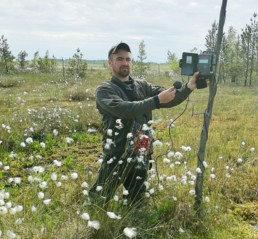
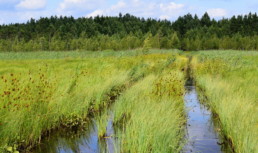
It has been decided that prior to the construction works, experts will conduct a one-year-long hydrological monitoring as well as peat layer analysis. It will allow assessing the present water levels in the project territories and then evaluating the efficiency of the restoration. The proposed monitoring methodology and further modeling based on the data obtained was elaborated and successfully tested by Polish experts.
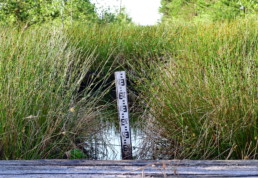
During a round-table session that took part at the National University of Water and Environmental Engineering in Rivne, experts discussed the value, present state, threats and prospects of the Polesian wetlands. Among other topics, they touched upon the historical importance of mires as natural barriers during military conflicts which is unfortunately up on the agenda today. We hope that this aspect will lose its urgency very soon. However, mires in Polesia, being a source of drinking water for millions of people, an effective carbon storage and a hotspot of biodiversity, are worth being restored and preserved for generations to come.
Safe and intact: protecting rare and typical habitats in Polesia
19. September 2025
0 Comments7 Minutes
The project “Polesia – Wilderness Without Borders” is part of the Endangered Landscapes & Seascapes Programme and is funded by Arcadia. The project is coordinated by Frankfurt Zoological Society (FZS).
This post is also available in UKR.


